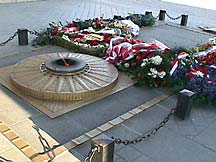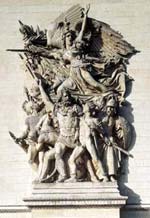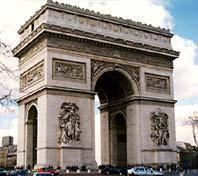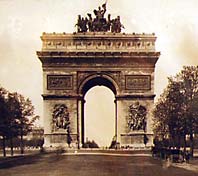History
The Arc de Triomphe de l'Etoile {ahrk duh tree-ohmf' duh lay-twahl'}, the world's largest triumphal arch, forms the backdrop for an impressive urban ensemble in Paris. The monument surmounts the hill of Chaillot at the center of a star-shaped configuration of 12 radiating avenues. It is the climax of a vista seen the length of the Champs Elysées from the smaller Arc de Triomphe du Carrousel in the Tuileries gardens, and from the Obélisque de Luxor in the place de la Concorde.
In 1806, Napoleon I conceived of a triumphal arch patterned after those of ancient Rome and dedicated to the glory of his imperial armies. The structure was designed by Jean François Thérèse Chalgrin (1739-1811), completed in 1833 and inaugurated in 1836 by the French king, Louis-Philippe. Its deceptively simple design and immense size, 49.5 m (162 ft) in height, mark it unmistakably as a product of late 18th-century romantic neoclassicism. The arch also serves as a reminder that Chalgrin was a pupil of Etienne Louis Boullée, the father of visionary architecture. The most famous of its sculptural reliefs is La Marseillaise (1833-36) of François Rude. Specific historic associations notwithstanding, the arch has become an emblem of French patriotism.
 The Tomb of the Unknown Soldier commemorates the dead of the two world wars. | |
Since 1920, the tomb of France's Unknown Soldier has been sheltered underneath the arch. Its eternal flame commemorates the dead of the two world wars, and is rekindled every evening at 6:30. Here, on every Armistice Day (November 11), the President of the Republic lays a ceremonial wreath. On July 14, the French National Day (also known as Bastille Day), a military parade starts at the arch and proceeds down the Champs Elysées. For important occasions of state, and on national holidays, a huge French tricolor is unfurled and hung from the vaulted ceiling inside of the Arch. The last leg of the Tour de France bicycle race also culminates here on the third or fourth Sunday in July.
Physical Description
At the bases of the Arc's pillars are four huge relief sculptures, commemorating The Triumph of 1810 (by Cortot); Resistance, and Peace (both by Etex); and The Departure of the Volunteers, more commonly known as La Marseillaise (by François Rude). On the day the Battle of Verdun started (1916), the sword carried by the figure representing the Republic broke off from La Marseillaise. The relief was immediately hidden to conceal the accident, so that it would not be interpreted as a bad omen.
 Detail of La Marseillaise by François Rude. | |
Engraved around the top of the Arch are the names of major victories won during the Revolutionary and Napoleonic periods. The names of less important victories, as well as those of 558 generals, can be found on the inside walls. (Generals whose names are underlined died in action.)
« Click here to see relief detail of Napoleon being crowned. »
Admission
Inside the Arch, a small museum documents its history, architectural design and construction — complete with interactive touch screens. The price of admission includes access to the top of the Arch. From the roof, one is treated to spectacular views of Paris. Looking eastwards, down the Champs Elysées, toward the Louvre, there is the Place de la Concorde, the Tuileries Gardens, and the Arc de Triomphe du Carrousel. In the opposite direction - westwards - in the distance is its larger and newer cousin, La Grande Arche de la Défense.

If you are planning to visit many monuments and museums during your séjour à Paris, Discover France offers the "Museums and Monuments Card" (Carte Musées et Monuments), valid for unlimited visits and priority access to approximately 70 locations in — and near — Paris. It can also be purchased at theParis Tourist Office (127, avenue des Champs-Elysées), at its reception offices in certain Paris train stations, at the Eiffel Tower, in the major Métro stations, or at most of the 70 attractions. Cards are available in denominations valid for either one, three, or five consecutive days.


ไม่มีความคิดเห็น:
แสดงความคิดเห็น